Goat Udder Information
You may also want to read these pages because the subjects are very closely related:
The proper term for a goat's mammary glands are called her "udder". It is not properly called a "milk sack" though is is sometimes referred to as her "bag". It is most polite to say "udder".
When a doe's udder starts to form for the first time, or an already formed udder starts filling with milk, this is called "making her udder". When her udder really starts seriously filling with milk, this is called "bagging up".
What to look for in a Good udder
Udders need to have good "attachments", that mean how the udder attaches to the body. The udder should be held up high and tight to the body and not hang down and sag. A sagging udder will not get any better and will only get worse. You do not want a sagging udder because an udder that hangs low will not hold up to many years of milking, will be difficult to milk because it hangs lower than the milk pail, and most importantly, risks damage (I have seen a low hanging udder get ripped open from getting caught on a protruding object, leading to the need for a total mastectomy)
Teat & orifice size
If you are going to be hand milking, you want teats that are big enough to comfortably milk. Also, the "orifice" (hole the milk comes out of) is important. If the hole is tiny, it will take forever to milk the doe. A doe can have big teats but small orifices so it's always good to "test milk" a doe your are considering purchasing for a milker. Teats can get bigger over time, orifices don't usually get any better. I have not found orifice size to be genetic, but teat size is.
If you have dairy goats, you should keep a California Mastitis Test, or something similar, on hand at all times. You need to be able to test your goats for mastitis.
Udder Related Questions & Answers:
- Is it possible for a doe to start filling her udder and make milk without ever being pregnant?
- How long before a doe is due to kid will she start making her udder?
- How long soon before kidding will a doe's udder start filling with milk?
- What if the kid (or kids) is/are only nursing from one side of the udder?
- Does letting the kids nurse their mother "ruin" or tear up the udder?
- My doe has kind of formed her udder, but her teats are still small and not starting to elongate. They are still the same size as when she was never pregnant. This is her first pregnancy. Is it normal for her teats to still be so small, or is there something I should do for her?
- I think my doe might be getting really close to going in to labor. I've looked at so many of the photos on your web site and others' web sites and my goat does not have that "big bag" like I see in the photos. Is this normal?
Is it possible for a doe to start filling her udder and making milk without ever being pregnant?
Yes. This is what is called being "precocious" and it is not uncommon. On rare occasion, a doe may start making milk without being bred. It is best to just let it be and not milk her. She will eventually reabsorb the "milk". She will probably be a very good milker once she is bred, kids, and begins a true lactation. It will not effect her udder negatively once she kids. From our experience, every precocious doe we've had has filled up on one side more than the other, but once they kidded, they had very nice even udders.
How long before a doe is due to kid will she start making her udder?
How long soon before kidding will a doe's udder start filling with milk?
Be aware that every doe and every situation is different. You estimate a general amount of time, but this can vary greatly. Yes, it would be nice to know an exact length of time, but this is really impossible to give.
In general:
First Time Mother To Be: A doe will start developing her udder for the first time ~about~ a month before she kids for the first time, though this can vary greatly between individual does. Be ware that first timers will have smaller udders and teats than does who have had and nursed kids before.
Experienced Does: A doe that has kidded before may start filling her udder ~anywhere~ from a month to just days, or ever hours before she kids. It is uncommon, but entirely possible, for a doe to wait until just hours before kidding or even right when she goes into labor to fill her udder. We've had a doe who didn't start coming into milk until a few days after kidding. In this case, we gave her Mo'Milk to stimulate her milk production.
What if the kid (or kids) is/are only nursing from one side of the udder?
Often when a doe has only one kid (and sometime when she has two), it is very common for the kid(s) to nurse only one side. They pick a teat they like and stick with this, totally ignoring the other teat. This starts a "vicious circle" because the more full the udder and teat becomes, the harder it is for the kid(s) to get the teat in his mouth and nurse, thus, the kid(s) will choose to suck only the "easier" teat. It will become a favorite, the baby will not even think about going to the other side, even if his "favorite" is empty.
At every opportunity you get, you should try to get the kid(s) to nurse the side they are ignoring. Be patient, this may be a bit frustrating.
If the ignored side gets really full, you must milk it out so that the mother's udder isn't so full she is in pain. You do not have to milk it out completely, but at least enough to relieve the pressure and make it easier for the kid to nurse. Eventually, as the kid(s) grows and can drink more milk, he will start to nurse the other side, but until them, you need to be "the second kid".
I've had situations where each kid has his and /her own teat and when the boy left for his new home, the mother would not allow, and the doe refused to try to nurse the boy's side... no matter how full it got. I eventually had to just milk the one side every day (I could use the milk, so I did not mind)
Does letting the kids nurse their mother "ruin" or tear up the udder?
No. Goats are designed by nature to nurse their kids. If the doe has a decent udder, with good attachments, to begin with, letting her nurse her kids will not "ruin" her udder. I sometimes feel this myth is told as a justification to "pull" the kids from their mothers. If you want proof that nursing kids does not ruin an udder that started out as a good udder to begin with, please take a look at the udders below. These are does that have raised and nursed many kids. I milk them once a day and you can plainly see these udders have not been ruined.
A thing that can cause the udder to become lopsided is if only one side of the udder is nursed. In this case, you may need to milk the doe. I have had does become lopsided one year, then the next year "straighten out" with no problem. Please refer to "What if the kid (or kids) is/are only nursing from one side of the udder?
| All of the following does have nursed all of their own kids. You can see their udders have not been ruined. |
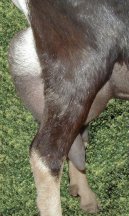 Max's udder - 4 kiddings Max's udder - 4 kiddings |
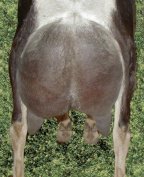 Max's udder - 4 kiddings Max's udder - 4 kiddings |
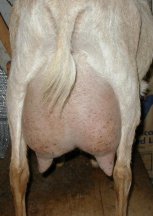 Goldie's udder - 6 kiddings Goldie's udder - 6 kiddings |
At the time this udder photo was taken, Ovalteenaweenia was feeding her two, 2+ month old kids PLUS producing 6.5 pounds a milk for me each day (milking once a day) (8 pounds equals one gallon) |
My doe has kind of formed her udder, but her teats are still small and not starting to elongate. They are still the same size as when she was never pregnant. This is her first pregnancy. Is it normal for her teats to still be so small, or is there something I should do for her?
Yes, the teats on a first timer are small. They will get bigger over time as she holds milk in her udder, as her kid nurses, and you milk her. I usually don't even milk first time mothers because their teats are so small. Also, teat size varies from doe to doe, so it is possible you have a small teated doe. You should look at the doe's mother to get an idea of the size her teat may eventually be.
Do nothing now; they should get bigger over time. Be patient.
I think my doe might be getting really close to going in to labor. I've looked at so many of the photos on your web site and others' web sites and my goat does not have that "big bag" like I see in the photos. Is this normal?
The "big bag" udder photos are does that have kidded before. A first freshener's (first time mother's) udder will be smaller. Her teats will also be smaller. Her udder and teats will get larger as she nurses her new kids and the next time she kids her udder will also be larger. First freshener do not produce as much milk as does that have lactated before, hence, smaller udders. However, if a first timer is properly taken care of, she should have no problem producing enough milk for 2-3 kids.
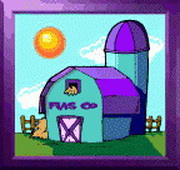
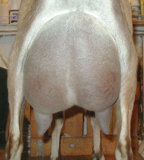 Ovalteenaweenia's udder
3 kiddings
Ovalteenaweenia's udder
3 kiddings